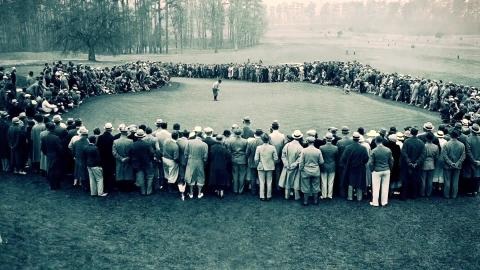- MENU
- HOME
- SEARCH
- WORLD
- MAIN
- AFRICA
- ASIA
- BALKANS
- EUROPE
- LATIN AMERICA
- MIDDLE EAST
- United Kingdom
- United States
- Argentina
- Australia
- Austria
- Benelux
- Brazil
- Canada
- China
- France
- Germany
- Greece
- Hungary
- India
- Indonesia
- Ireland
- Israel
- Italy
- Japan
- Korea
- Mexico
- New Zealand
- Pakistan
- Philippines
- Poland
- Russia
- South Africa
- Spain
- Taiwan
- Turkey
- USA
- BUSINESS
- WEALTH
- STOCKS
- TECH
- HEALTH
- LIFESTYLE
- ENTERTAINMENT
- SPORTS
- RSS
- iHaveNet.com: Golf

The Masters Tournament, despite its current status as one of the most prestigious events in golf, had humble beginnings rooted in the vision of one man: Bobby Jones.
Bobby Jones, an accomplished amateur golfer, dreamed of creating a tournament that would bring together the best players from around the world. In 1930, with the assistance of investment banker Clifford Roberts, he set out to establish what would become the Masters Tournament.
Initially known as the Augusta National Invitation Tournament, the inaugural event took place in March 1934 at Augusta National Golf Club in Augusta, Georgia. The club itself had been founded in 1931, with the renowned golf course designed by Alister MacKenzie and Bobby Jones. vThe tournament attracted a field of 72 players, composed of top professional and amateur golfers. Horton Smith emerged as the first Masters champion, winning by two strokes over Craig Wood. The first Masters purse was $5,000, with Smith receiving $1,500 as the victor.
In the early years, the tournament faced financial challenges and struggled to establish a reputation among other major championships. However, the vision and dedication of Jones, Roberts, and other organizers helped propel the Masters Tournament towards success.
One of the key turning points for the tournament's growth came in 1954 when the Masters began receiving extensive television coverage. This exposure allowed the event to reach a broader audience and gain recognition beyond the golfing community.
Over the years, the Masters Tournament evolved and developed its unique traditions and iconic moments. The presentation of the green jacket to the champion began in 1949, becoming a symbol of golf excellence. Amen Corner, the famous stretch of holes 11, 12, and 13, gained notoriety for its potential to shape the outcome of the tournament.
Today, the Masters is known for its meticulous course conditions, beautiful azalea-lined fairways, and the natural beauty of Augusta National. The tournament attracts the world's top golfers and remains one of the most prestigious and eagerly anticipated events in golf.
From its humble beginnings as the Augusta National Invitation Tournament to its current status as a beloved major championship, the Masters Tournament has achieved greatness through its rich history, commitment to tradition, and the passion of those involved in its growth.
The Masters Tournament, one of golf's four major championships, has played a significant role in shaping modern professional golf in several ways:
Tradition and Prestige
The Masters is steeped in tradition and history, being first played in 1934. Its iconic green jacket, awarded to the winner, has become synonymous with golf greatness. The tournament's prestige and aura have elevated the status of professional golf and added a sense of reverence to the event.
Global Attention
The Masters attracts worldwide attention, drawing viewers from around the globe. Its television coverage and media presence have helped popularize the sport and expand its reach to new audiences. The tournament's exclusivity and limited field add to its allure, making it a must-watch event for golf enthusiasts.
Augusta National Golf Club
The Masters is played annually at Augusta National Golf Club, a revered golf course known for its beauty, meticulous maintenance, and challenging layout. The course has become a symbol of golf excellence and sets the stage for dramatic moments during the tournament. Its iconic holes, such as Amen Corner (holes 11, 12, and 13), have become legendary in golf lore.
Tradition Unlike Any Other
The Masters has its own unique traditions that have become part of golf's fabric. The ceremonial opening tee shot, the Par 3 Contest, the honorary starters, and the green jacket ceremony are all cherished aspects of the tournament. These traditions have helped create a distinct identity for the Masters and add to its enduring appeal.
Influence on Course Design
Augusta National's design and its significant influence on golf course architecture cannot be overstated. The course's emphasis on strategic shot-making, its undulating greens, and its incorporation of natural beauty have inspired course designers around the world. Many golf courses now aim to replicate the challenging and aesthetically pleasing aspects of Augusta National.
Financial Impact
The Masters has had a substantial financial impact on professional golf. The tournament's sponsorship deals, television contracts, and ticket sales generate significant revenue for the sport. The financial success of the Masters has contributed to the growth and sustainability of professional golf as a whole.
Career Milestones
Winning the Masters is a career-defining achievement for professional golfers. The tournament's historic significance and prestige elevate a player's status and can solidify their legacy. Masters champions, such as Jack Nicklaus, Arnold Palmer, and Tiger Woods, have become legendary figures in the sport due in large part to their successes at Augusta National.
Overall, the Masters Tournament has shaped modern professional golf by establishing a standard of excellence, amplifying the sport's global appeal, influencing course design, and providing a platform for remarkable performances and career milestones. Its unique traditions, historic significance, and lasting impact continue to make it one of the most important and highly anticipated events in the golfing world.
Article: Copyright © iHaveNet.com.
"The Masters Humble Beginnings"